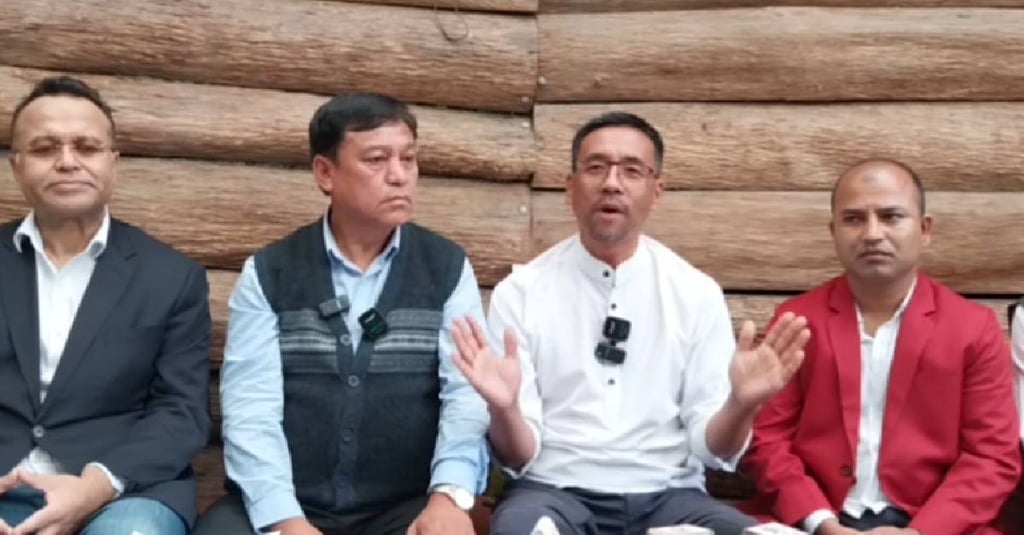Gorkha leaders push for Sikkim-Darjeeling integration, cite Article 371F and historical rights
Singh said that the demand is not emotional but based on facts, laws and records. “We are not making things up. All this is public knowledge. We’ve observed these facts for months and are speaking now because we feel there’s an active conspiracy to keep Darjeeling separated,” he said.
LOCAL


In a press conference held in Gangtok, Chief Convenor of Gorkha Seva Sena, Bikram Adi Rai along with leaders from the Gorkha Rashtriya Congress (GRC) on June 4 made a strong case for the integration of Darjeeling and Kalimpong with Sikkim. The leaders cited constitutional provisions, historical records and unanswered RTI queries to support their claim, calling for national attention to what they termed a "genuine and rightful demand."
Rai said that an RTI had been filed on behalf of the Gorkha Seva Sena concerning Clause H of Article 371F, which relates to the properties and territories of Sikkim. “We were invited today by the Home Department for a hearing, but unfortunately, our questions still remain unanswered,” he said. “The issue is about land and assets belonging to Sikkim, including those outside its borders, and the specific territories referred to in the clause. We were directed on how to move forward, such as approaching the Appellate Authority.”
Rai added that integration cannot happen by hurting the pride of Sikkim. He emphasized that maintaining a cordial and emotional bond between Darjeeling and Sikkim is key to any future discussion. “There are elements who are trying to destroy this harmony. If we lose that, integration is not possible,” he said. “We respect Sikkim’s identity and honor. Integration should not come at the cost of its self-respect.”
Subodh Pakhrin, a representative of the GRC spoke on the technicalities and said that the Article 371F gave Sikkim special provisions after its merger with India in 1975. Clause (h) clearly mentions that all movable and immovable properties within and outside Sikkim should be returned to the state. This includes properties in places like Kolkata and even diplomatic offices abroad. “Darjeeling, we believe, is part of these properties and territories,” Pakhrin said.
He referred to statements from Wangden Lepcha during the Sikkim Council sessions between 1963 and 1968. “At that time, Darjeeling was discussed as a resource belonging to Sikkim. The government of India and the President have powers under Articles 1 to 3 to resolve land disputes. We want similar action taken for Darjeeling,” he added.
On being asked if the focus on Sikkim-Darjeeling integration meant that the dream of Gorkhaland was over, Pakhrin replied, “No, this is not about abandoning Gorkhaland. It’s about presenting historical and legal facts. We’ve worked on this for 25 years based on evidence. The Sikkim government itself invited us for today’s hearing, which shows our demand is being taken seriously.”
Rai on the other hand said that Kalimpong was historically under Sikkim and not separate. He mentioned a 1937 notification from the Sikkim Palace that allowed Sherpa and Tamang communities to settle east of the Teesta, which includes Kalimpong. “There is a misconception that Kalimpong is not part of Sikkim, but records prove otherwise,” he said.
Convenor of the Gorkha Seva Sena, Subash Singh supported the historical claim, citing the Anglo-Bhutan war of 1864, the Sinchula Treaty of 1865, and the inclusion of Kalimpong in Darjeeling under the Bengal District Act by 1866. “The Indo-Sikkim Friendship Treaty and Indo-Nepal Treaty signed in 1950 also affect this case. It’s complicated, but we have documents to prove our point,” said Singh.
He further said that the Darjeeling Hill area has not been fully integrated into Bengal’s land records, which makes it a unique case. “Even the Home Department of Sikkim does not have complete clarity on the implementation of Article 371F,” he added. “This is why we are asking for proper enforcement of the law that was passed when Sikkim joined India.”
The leaders handed over copies of historical documents to the Home Secretary, including records of financial arrangements between Sikkim and the British for Darjeeling, which continued until 1975. “Even now, Darjeeling is not fully part of Bengal legally. It’s a hill area with a special status,” one of them pointed out. “Under ( clause l ) of Article 371F, the President has powers to amend old treaties, and we request this be done to include Darjeeling in Sikkim.”
Singh said that the demand is not emotional but based on facts, laws and records. “We are not making things up. All this is public knowledge. We’ve observed these facts for months and are speaking now because we feel there’s an active conspiracy to keep Darjeeling separated,” he said.
When asked if this demand might further complicate the already sensitive relationship between Bengal and the Gorkhas, Rai responded, “We are not here to create tension. We came cordially on official invitation and we will leave in the same spirit. But we will keep raising our voices.”
The Gorkha Seva Sena and GRC reiterated their call for a peaceful, respectful, and lawful resolution to the long-standing issue. “We do not want to hurt Sikkim’s identity or disrespect any state. We are only asking for justice based on historical facts, legal provisions, and constitutional rights. Without enforcing Article 371F properly, integration remains incomplete,” said Rai
